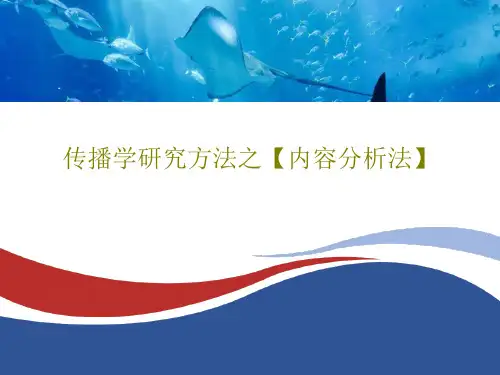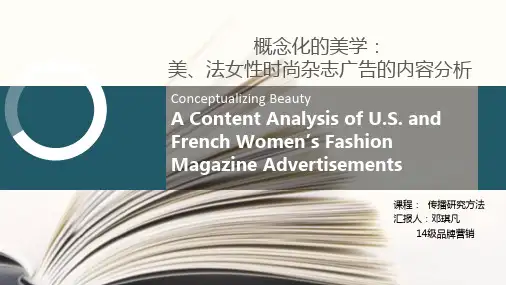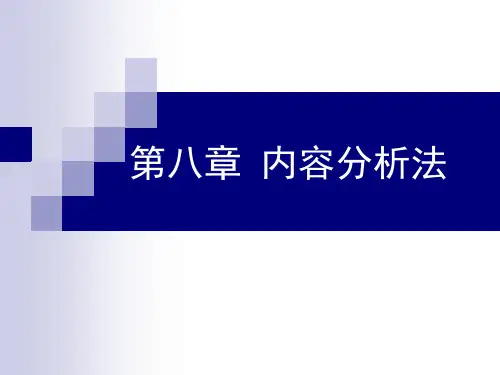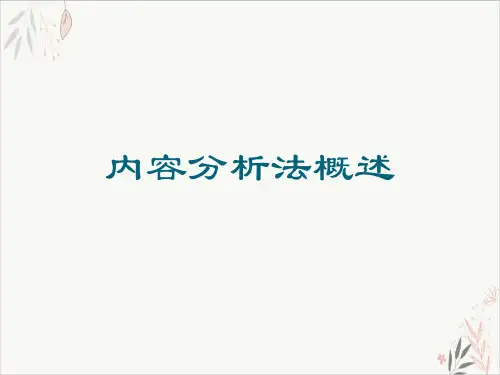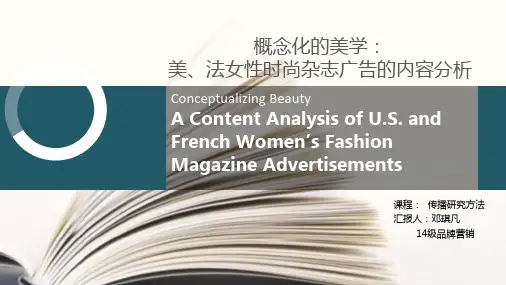- 1、下载文档前请自行甄别文档内容的完整性,平台不提供额外的编辑、内容补充、找答案等附加服务。
- 2、"仅部分预览"的文档,不可在线预览部分如存在完整性等问题,可反馈申请退款(可完整预览的文档不适用该条件!)。
- 3、如文档侵犯您的权益,请联系客服反馈,我们会尽快为您处理(人工客服工作时间:9:00-18:30)。
Part 4
为啥选你捏?
总而言之
经过千辛万苦的筛选过程,和老师的细心教诲。前后 换了三遍论文,在汲取每一次失败经验的基础上,加 深了对“内容分析法”的理解。最终通过文 章结构脉络、条理、内容、以及研究
兴趣使然:选题有趣
结构清晰 方法明显
为啥
方法的使用,定下这篇文章,与大家分享,希望大
家对内容分析法有一个更深入的了解。
Pamela K. Morris & Katharine Nichols, Loyola University Chicago, USA
通过对比美法两国一些女性时尚杂志中的 广告,研究了在媒介影响的环境下,不同 文化中的审美观念,(尤其是女性对于自 身的审美)
4
Part 1
Part 2
Part 3
梳理以往文献 整理出几个观点 提出研究问题
Part 1
Part 2
Part 3
Part 4
文献分析
摘 要
摘要: 现如今,尽管“美”是已经成为一个主要产业,但它依旧是基于本土 Although beauty is a major industry, it is elusive and based 文化,并且难以捉摸的。本研究的目的是通过对于美国法国女性杂志中广告 on culture. The purpose of this investigation is to expand the 的研究对比,从而将女性美的观念向一个超越物理特性的方面扩充。超过来 idea of female beauty beyond 自十期女性时尚杂志中的 570个广告被进行内容上的分析。其中,主要研究 physical characteristics through an exploration of women’s 结果表明,美国出版物的相比于法国出版物而言含有更多的护发产品和化妆 magazine advertisements from France and the United States. 品,相比之下,法国杂志则含有更多的乳液和香水广告。在基调方面,美国 翻译 Over 570 ads from ten 出版物上的人物形象展现出更多的微笑,而法国出版物中的人物形象则展现 women’s fashion magazines are content analyzed. Among the 出更多奇异与性感。美国广告相比于他们的法国同行而言,展示了更多的女 major findings is that American publications consist of more 性形象,非工作女性形象,是以及装饰性的女性形象。法国出版物中的广告 hair care and makeup products 则更偏向于有家庭的男士和代言人的形象。以上的这些说明了在广告出版中, than in France, in contrast…. Keywords: Beauty, Culture, 本地文化的优先性和审美观念的不同。 Advertising, Content Analysis, Fashion 关键词:审美,文化,广告,内容分析,时尚
10
更是一种文化的传递。
广告业是人们反映自身行为的一面 照镜子,反映出人们如何对社会态 度和生活方式产生想法与形成影像。
·广告中的代言、美化等成分,具 有夸大作用,必然加强特定的文 化价值,从而使其忽略其他。
Part 1
Part 2
Part 3
Part 4
文献分析
·涵化理论:即潜移默化的效果,最
· Cultivation theory (Gerbner, 1998; Gerbner, Gross, Morgan, & Signorielli, 1994).
概念化的美学: 美、法女性时尚杂志广告的内容分析
Conceptualizing Beauty
A Content Analysis of U.S. and French Women’s Fashion Magazine Advertisements
课程: 传播研究方法 汇报人:邓琪凡 14级品牌营销
目录页
初用于电视媒体,现在被广泛运用。
受众接触媒体越多,对他们而言那些 传播的信息图像和想法的可信度就越 高。 ·现在的“图像着迷”文化盛行,人 们喜欢通过图像来看待事物,在这样 的环境下,说明一个女性具有吸引力 的标志就是(大眼睛、好皮肤、丰唇 等),而女性们正在潜移默化接受这 种大众媒体所给予的定义。
再不选好,就真的做不完了……
5
文献分析
Part
2
Part 1
Part 2
Part 3
Part 4
文献分析
大致说明 现状 不足 为什么选择“美法” 研究什么
文献 综述
差异 审美差异 文化差异 广告差异
摘要
前言
Hale Waihona Puke 研究 方法如何运用 样本选择 信效度分析 编码过程 发现(结果)
7
结论
限制 与 展望 样本多样性 互联世界
11
Part 1
Part 2
Part 3
Part 4
文献分析
·说明了本研究的重要性,能够解决 怎样的问题。首先、女性会因为这些 特定的审美观念而产生自卑等心理问 题。其次、还要充分考虑审美的跨文 化性,不是每个地方的审美观念都是 相同的。 ·主要讲了以前美法出版物中的广告 对比,这方面研究取得的成果。但在 这两个国家 “美的观念”的对比, 却没有研究。
8
Part 1
Part 2
Part 3
Part 4
文献分析
前 言
· As socializing agents, models in mass media and advertisements create cultural norms and define standards of beauty in society (Frith, Shaw, & ·大众传播媒介能够影响人们对于美的定义及标准,但这些影响 Cheng, 2009). However, these ideals are unrealistic and can cause 可能会使女性产生不好的情绪。 feelings of anger, anxiety, depression, and insecurity among women ·尽管美的跨文化研究领域受到一些限制,但仍有一些研究将美 (Goodman et al.). · Although cross-cultural studies of beauty in advertisements are limited, 国“如何描述美丽”与其他国家进行对比。 a few have compared attractiveness and beauty portrayals in the United ·有学者认为不能用一套特定的审美观念来定义美,这样过于狭 States with other nations, including Korea (Bissell & Rask), Iran (Hanjani, 隘(大眼儿,厚嘴唇,好皮肤……)这让一些美国女性无法接受。 2011), Singapore and Taiwan (Frith et al., 2009), and Germany (Piron & Young, 1996). ·本研究在一个更广阔的的文化范围内以一个不同的视角来进行 · However, Wolf (1992) argues that a single set of characteristics cannot 审美。 the idea of beauty and the narrow cultural concept of represent attractiveness especially in the United States only makes women feel ·【关于研究问题的提出与样本的选择,请见下回分解】 “inadequate and unacceptable” (Bissell & Chung, 2009, p. 228). · This investigation attempts to take a different perspective of beauty by viewing it through a broader cultural lens.
CONTENTS PAGE
P1. 文献介绍
P2.文献分析
P3.总结、建议
P4.心得(吐槽)
文献介绍
Part
1
Part 1
Part 2
Part 3
Part 4
文献介绍
Online Journal of Communication and Media Technologies
出处 时间 作者 内容
Volume: 3 – Issue: 1 – January - 2013
文献 综述
· Specifically, in the current imageobsessed culture where women are exposed to narrow ideas of attractiveness, primarily described as young, thin, big eyes, full lips, flawless skin, and high cheek bones (Goodman et al., 2008), women will more likely think these images are real and attainable (Bissell & Chung). Ideal images can leave women with feelings of unhappiness and dissatisfaction particularly in terms of self-image, eating disorders, and other culturally-induced diseases (Bissell & Chung; Hesse-Biber, Leavy, Quinn, & Zoino, 2006; Goodman, et al.; Richens, 1991).

